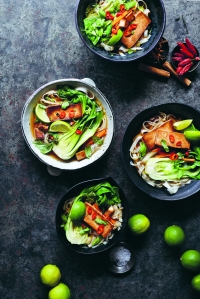Family Food and Feelings
Kate Berry
Pan Macmillan
Plum
ISBN: 978176078-180-4
RRP 39.99
Green Fritters
“Fritters are a bit of a fave for us. I like them because I can cook a ton of them for dinner and then chuck the leftovers in the girls’ lunchboxes the next day. The girls like them because they’re fried and have a dipping sauce. I like them for that reason too, actually.”p202
220 g green beans, quartered
220 g fresh or frozen and thawed peas
220 g podded and peeled broad beans
4 spring onions, green andwhite parts, sliced
1 garlic clove, crushed
finely grated zest of 1 lemon
salt and pepper
1 free-range egg
300 g (2 cups) plain flour
560 ml (2 ¼ cups) sparkling water
sunflower or vegetable oil, for shallow-frying
pinch of sumac
your choice of fresh herbs,
to serve (optional)
For the cucumber yoghurt:
½ Lebanese cucumber, coarsely grated
salt
500 g (2 cups) plain yoghurt
3 tablespoons extra-virgin olive oil
juice of ½ lemon
1 garlic clove, crushed
handful of mint leaves, roughly chopped
salt and pepper
To make a start on the cucumber yoghurt, pop the grated cucumber in a colander over a bowl. Add a big pinch of salt and rub it into the cucumber, then leave for about an hour to get rid of the excess water.
While that’s happening, make the fritter mixture. Combine the green beans, peas, broad beans, spring onion, garlic, lemon zest, salt and pepper in a large bowl. In a separate bowl, mix together the egg and flour, then slowly
whisk in the sparkling water. It should be the consistency of thick cream so take it slowly – you may not need all the water. Pour the batter into the bowl with the veggies and mix well.
Preheat the oven to its lowest setting. You just need it to keep
the fritters warm.
Heat a generous amount of sunflower or vegetable oil in a large heavy-based frying pan over medium–high heat.
It’s ready when you pop a piece of veg in there and it sizzles. Add heaped tablespoons of batter to the oil and be careful not to get spattered.
Fry the fritters for 2–3 minutes each side or until golden brown and cooked through. Remove with
a slotted spoon and drain on paper towel. Keep warm in the oven while you cook the remaining fritters.
To finish off the cucumber yoghurt, give the cucumber a squeeze to remove the last bits of water. Place in a mixing
bowl with the yoghurt, olive oil, lemon juice, garlic and mint and stir well. Season with salt and pepper.
To serve, spoon the cucumber yoghurt onto plates and pop the fritters on top. Sprinkle with sumac and top with
some fresh herbs, if you like.
MAKES 16-18 FRITTERS
‘Family, Food and Feelings by Kate Berry, Published by Plum, RRP $39.99, Photography by Kate Berry’


















